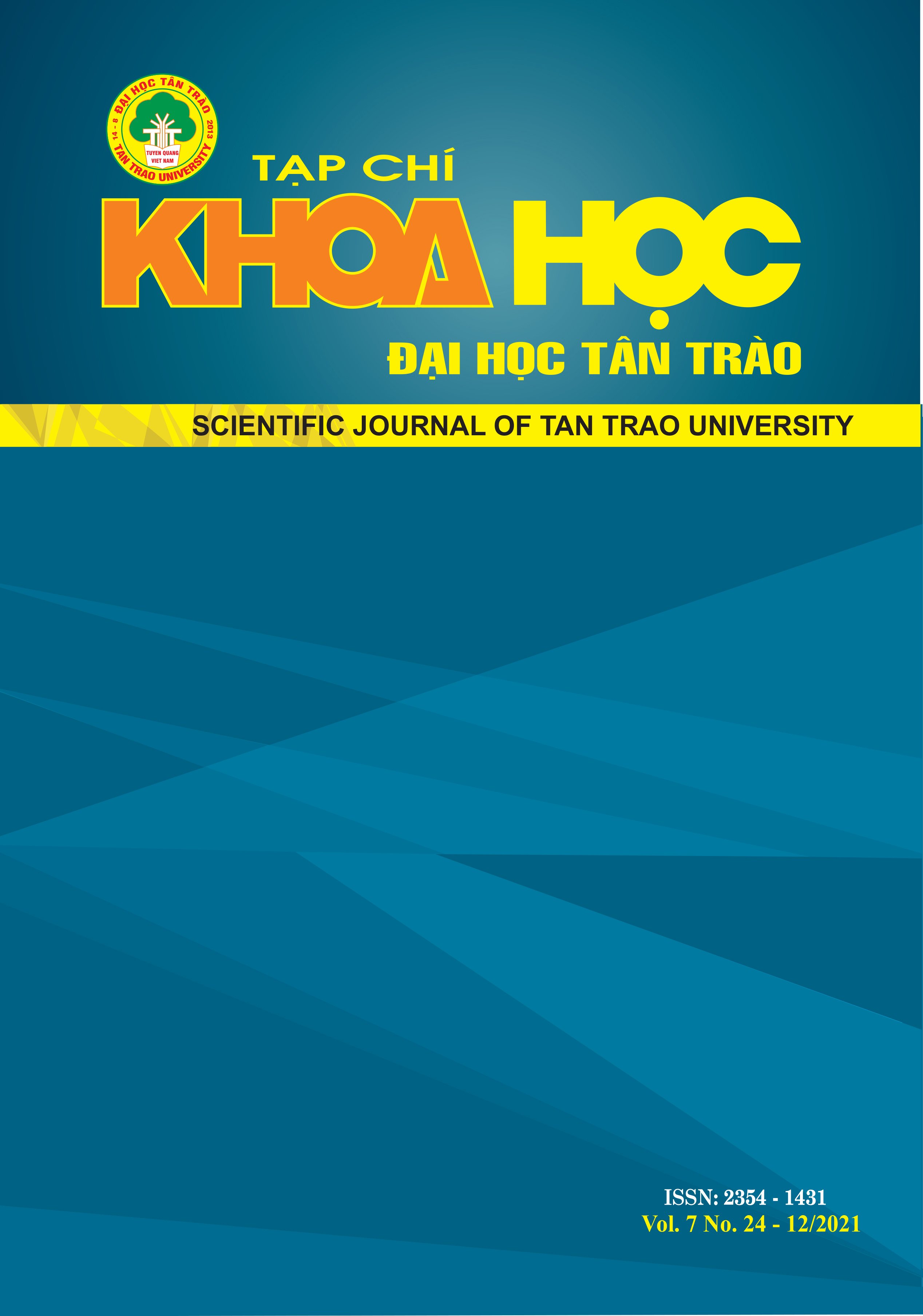A STUDY ON THE PROCESS OF POLYSACCHARIDE EXTRACTION FROM MYXOPYRUM SMILACIFOLIUM (WALL.) BLUME ROOTS
DOI:
https://doi.org/10.51453/2354-1431/2021/603Abstract
Myxopyrum smilacifolium (Wall.) has been demonstrated to contain many bioactive compounds, including polysaccharides, saponin, and flavonoids. This study aimed to determine the effects of the single-factor model on the attraction process as a basis for optimal performance. The obtained extract will be evaluated for its antioxidant capacity. The results of the single-factor when extracting the total polysaccharide from Myxopyrum smilacifolium (Wall.) showed the effects of the solvent concentration, solvent/material ratio, extraction time, and temperature on the extraction process with the corresponding results: ethanol 60% (v/v), 20/1 (ml/g), 75 minutes and 70°C respectively. The optimal conditions have been found for the total polysaccharide extraction from Myxopyrum smilacifolium (Wall.): ethanol concentration 66.58%, solvent/material ratio 20.46/1 (ml/g), extraction time 76.77 min, extraction temperature 70°C, respectively. Under the conditions, the total polysaccharide content of the extract reached 3.34937 mg/g of the raw material of Myxopyrum smilacifolium (Wall.) leaves. The extract from Myxopyrum smilacifolium (Wall.) gave an IC50 value of 522.56 ± 13.67 (µg/ml) when evaluating its antioxidant activity.
Downloads
References
REFERENCES
[1] Box, G.E.P. and Wilson, K.B., (1951). On the experimental attainment of optimum conditions (with discussion). Journal of the Royal Statistical Society Series B. 13 (1): 1-45.
[2] Quang, B.H., Chinh, V.T. (2011). Plant species are used as a medicine of Jasminum in Vietnam. The 4th National Scientific Conference on ecology and biological resources, p.1260.
[3] Chew, K.K., Ng, S.Y., Thoo, Y.Y., Khoo, M. Z., Wan, Aida, W.M., and Ho, C.W. (2011). Effect of ethanol concentration, extraction time and extractiontemperature on the recovery of phenolic compounds and antioxidant capacity of Centella asiatica extracts. International Food Research Journal, 18 (4): 1427 - 1435.
[4] Damaso Pauline, Igbonekwu-udoji Reagan Jonas, Hien, L.T.T., Thuy, L.T., Le, C.H., Son, L.H., Lam, V.D., Tinh, N.T., Luong, T.T., Hoa, D.T.K. (2020). Research on the extraction process of total polysaccharides from the ( Myxopyrum smilacifolium (Wall.) Blume) and evaluate the antioxidant activity. Scientific Journal – Tan Trao University, 17:36 – 41.
[5] Foster D. S. and Cornella T. S. (1961). Colorimetric Method of Analysis. Nostrand Company Inc New Jersey, 08, pp. 162.
[6] Binh, N.V., Phuong, P.T., Loi, N.T. (2018). Research on some factors affecting the extraction process of total polysaccharide content in Ganoderma lucidum. Journal of Science and Technology - Thai Nguyen University, No. 180 (04): 3 – 8.
[7] Institute of Medicinal Materials (2006). Methods of studying the pharmacological effects of drugs from herbal. Publishing House of Natural Sciences and Technology, Ha Noi
[8] Bac, V.H. (2018). Research on extraction and immune-enhancing effects of polysaccharides from the leaves of Pseuderanthemum palatiferum (nees) radlk. Journal of Biotechnology, 16 (2): 327-335.
[9] Gopalakrishnan S., Rajameena R. (2013), “Wound healing activity of the ethanol extract of the leaves of Myxopyrum serratulum A.W. Hill in rats”, International Journal of Pharmaceutical Sciences and Drug Research, 22(1), pp.143-147.
Downloads
Published
How to Cite
Issue
Section
License

This work is licensed under a Creative Commons Attribution-ShareAlike 4.0 International License.
All articles published in SJTTU are licensed under a Creative Commons Attribution-ShareAlike 4.0 International (CC BY-SA) license. This means anyone is free to copy, transform, or redistribute articles for any lawful purpose in any medium, provided they give appropriate attribution to the original author(s) and SJTTU, link to the license, indicate if changes were made, and redistribute any derivative work under the same license.
Copyright on articles is retained by the respective author(s), without restrictions. A non-exclusive license is granted to SJTTU to publish the article and identify itself as its original publisher, along with the commercial right to include the article in a hardcopy issue for sale to libraries and individuals.
Although the conditions of the CC BY-SA license don't apply to authors (as the copyright holder of your article, you have no restrictions on your rights), by submitting to SJTTU, authors recognize the rights of readers, and must grant any third party the right to use their article to the extent provided by the license.


